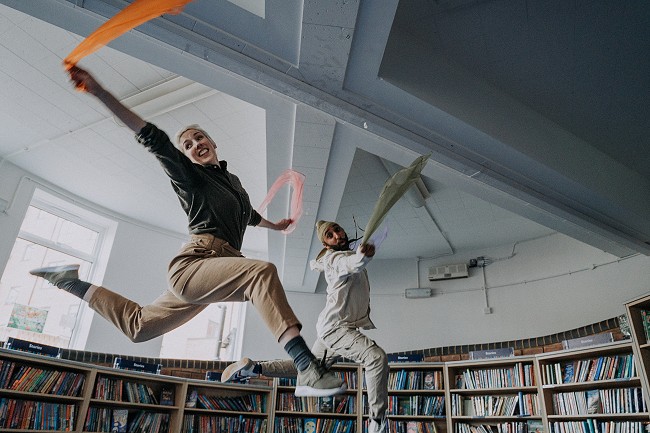
In 2024, we completed a period of research and development, rehearsals and a series of test performances of our new work SEED, our second professional dance work made for libraries, following hot on the heels of The Story Detectives.
SEED is a playful, interactive adventure for everyone, inspired by nature and the world around us. It is aimed particularly at children aged from 18 months to 4 years and their grown-ups, but can be enjoyed by all ages. It is about two characters called Kid and Pinto, both Seedologists on the look-out for new specimens. Together they follow the journey of a mysterious new seed that has appeared in the library, watching it transform as it travels through the four seasons.
The SEED project pilot was supported in 2024 by the National Lottery through Arts Council England, co-commissioned by Surrey Libraries and Active Surrey. Test performances were supported by Surrey Libraries, Medway Libraries/Applause Touring and Northamptonshire Libraries/Library Plus. The research for the project was also supported by The Hive in Guildford and Ruislip Manor Library (Hillingdon Libraries).
What we delivered
- In preparation for creating the piece, MBKG led 15 dance and story-telling workshops with groups of children under 5 and their grown-ups at Staines Library (Surrey), Ruislip Manor Library (Hillingdon) and The Hive in Guildford.
- We then offered 17 performances of SEED across 11 libraries and community centres in Surrey, Kent and Northamptonshire. These test performances aligned with this year’s Empathy Day and the Great Big Green Week from the Library Universal Offers Calendar.
- Alongside performances of SEED, MBKG offered wrap-around workshops in which children were able to plant and take away their own runner beans to grow at home. These were designed following on from training provided to us through our links with RHS Wisley.
- 502 audience members saw performances and 808 took part in the workshop sessions during the R&D and workshops linked to the performances.
Research and development (R&D) workshops
The SEED performance was created in response to feedback from members of our target audience with whom the company worked over 15 research workshops at libraries/community centres in Surrey and Hillingdon. These workshops consisted of reading a story about the environment together, taking part in a creative dance workshop based on that story and then a social session with creative activities for the children as a chance to find out more from parents about the impact of the project on participants.
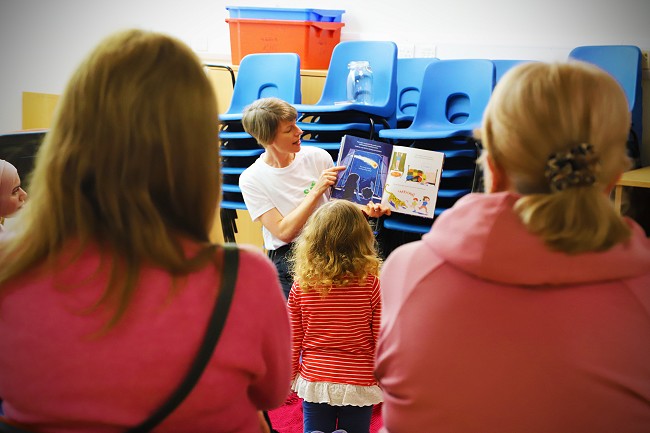
These workshops provided a crucial opportunity for the company to test the project content and engage with members of the target groups, so that their thoughts, ideas and responses could inform the shape of the final performance. Participants were then able to attend the final performances to see and celebrate the impact of their involvement on the final piece.
Alongside this direct impact on the project content, these sessions enabled the company to find out much more about the value of using dance/story-telling activities in communities. This included their accessibility and inclusivity, social benefits, the enjoyment they brought and confidence they built - increasing the impact on the participants’ awareness of nature and also the positive impact on parents as well as the children.
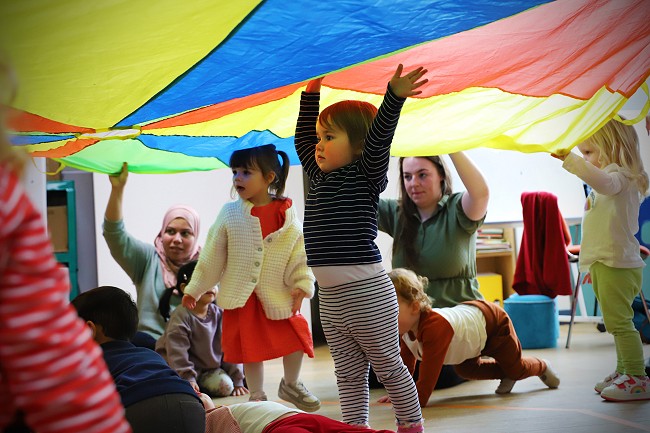
Performances
The 17 performances took place in Staines, Guildford, Esher and Dittons libraries in Surrey, Lordswood, Cuxton and Hempstead libraries in Medway, Rushden and Irthlingborough libraries in North Northamptonshire, and Brackley and Towcester libraries in West Northamptonshire.
SEED follows two characters, Kid and Pinto, played by dancers Megan Griffiths and Deepraj Singh, who learn about how things change and transform in nature.
When the children first arrive for the performance, they see a mysterious ‘seed’ in the library and throughout the piece everything that Kid and Pinto use to build an imaginative world in the library emerges from the seed – and at the end everything is packed away into it again. There are lots of props and materials for the children to interact with to help build this world, and a lively soundtrack plays via a small battery powered speaker, operated via Bluetooth so that the volume can be easily lowered or increased to suit the needs of the children.
The piece is playful, colourful and friendly, and at its heart is a strong message about the importance of community, listening and being kind to each other. After the 40 minute performance, there is the opportunity for the audience to take part in a seed planting session.

Generally, performances were very well attended, with a guidance capacity of 30 children and their grown-ups where the space allowed, but in some instances the company worked with fewer (where the children’s library areas were smaller), or welcomed more audience members where the spaces were more open (e.g. in Staines and Lordswood Libraries). Audience capacity was determined in close collaboration with the library staff at each location.
The libraries were provided with digital marketing materials, including images, a short film, e-flyers and social media assets to support them to reach their regular attendees and printed marketing including flyers and posters where these were requested. Rehearsal on-site in advance of the performances also provided an opportunity to raise awareness about what was happening amongst the library staff and regular library users.
Supporting children with special educational needs and disabilities (SEND)
The company received some recommendations from access consultant Lily Norton and mentor Hannah Lefeuvre in the final shaping of the SEED performance piece, which built on learning from touring The Story Detectives in 2022 and 2023 (some of which is outlined in the Story Detectives evaluation here).
Although it was originally intended to be non-verbal, some text was used throughout SEED to act as a narrative thread holding the sections together and to audio describe what was happening at certain points.
"[The story was] told very well by performing physically and verbal descriptions." (audience feedback)
Additionally, the company worked with a local BSL user to begin integrating signing into the performance.
12% of those completing surveys throughout R&D workshops and the performances said they were attending with a child with SEND and the company received some very positive feedback about their experiences.
My child loved it and you could see her go from unsure to having a great time. Really well structured. Also, really good for children with autism and the company managed to cater for our autistic child. Built a positive and trusting rapport with all the children in the session and just a really great experience.Parent feedback,
The company created a social story pdf to accompany the work, available online in advance as a hard copy on the performance days: https://madebykatiegreen.co.uk/admin/resources/social-story-seed.pdf . Parents were made aware of this as part of the introduction before the performances, as well as being told about some of its key points, including the fact that Katie would be able to turn the music down during the performance as needed, and directing people to a ‘chill out space’ made available in each library for anyone who needed a break from the performance.
Main Outcomes
The data we collected from audiences and participants throughout the SEED project indicated 8 main outcomes:
1. A new performance work which enhanced the magic of the library space
We successfully created a new performance work, and feedback suggests that the experience enhanced the library experience.
“It was brilliant to work with Katie and the performers. It went really well [...] Lots of positive feedback from very engaged parents. There were also a handful of children aged between six and eight who really enjoyed it. The audience were able to focus on the story and participate fully so they became absolutely immersed in the performance from start to finish which was fantastic to see.” (library partner feedback)
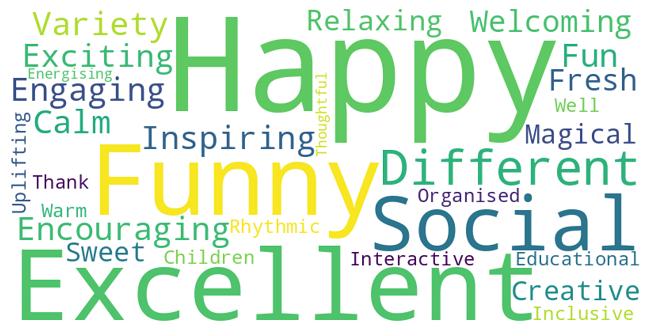
Parents described being attracted to take part in activities at the library that were distinct from other things being offered, with 48% saying they were particularly motivated to come because SEED brought something different.
“Fun. Wonderfully different. Unique and Engaging”
“Enchanting, Amazing, Energetic!” (audience and participant feedback)
2. Advancing our own practice for the success of the work and future projects, as well as the skills/experiences of our partners.
“This project enabled us to develop trust working with libraries over a longer period of time, which meant we were able to elicit more information from audiences/participants about what dance in the library could really mean to them and the impact it would have. We enabled people to see something they would never usually be able to see, for free, with the potential to have a transformative impact” (Katie Green, from reflective diary)
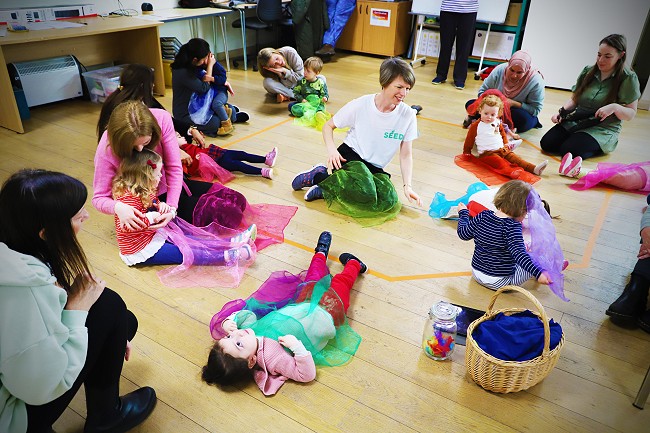
Every project we undertake gives the opportunity for us to develop our practice. This project specifically enabled us to work with accessibility and environmental consultants to improve our offer for the library context, particularly working with very young children.
This project has also led us to consider what additional engagement activity we could bring to library services and their linked schools and nurseries in the future, including opportunities
- for us to work with other dance artists to run regular dance/story-telling engagement sessions in their local libraries
- to create a linked programme of engagement activity for EYFS children in schools and nurseries linked with the ‘Understanding Our World’ learning area, which could culminate in the children creating their own dance, inspired by SEED.
We discovered more about the way in which the sessions extended the usual Rhyme/Story Time offer in libraries. Parents told us they provided an opportunity that (in some instances) was more inclusive and better suited their children’s needs, especially where their children found it difficult to focus or sit for a long time or where their child/ren had SEND for example.
“Katie was very lovely, calm and engaging. The children were really focused. The children loved all the props and the musical movement activities. Katie was really inclusive with the little girl I took with me who has autism. Katie really got her engaged with the story and activities.”Childminder feedback,
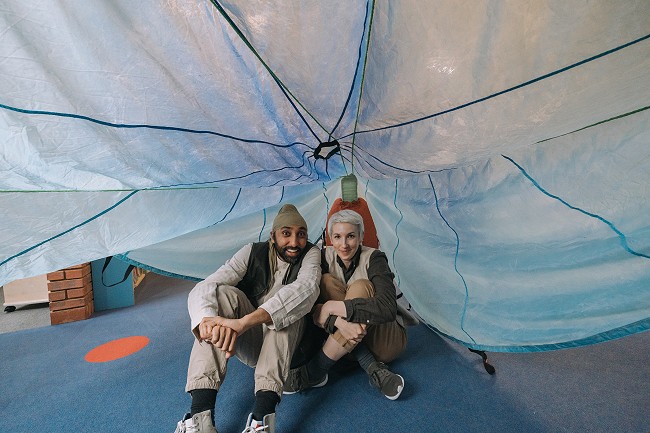
3. Improved access to high quality cultural activities in libraries
“The performance and performers were absolutely fantastic, interactive elements perfect and performers were fantastic - such high quality, thank you!” (audience feedback)
502 audience members saw performances and 808 took part in the workshop sessions during the R&D and seed-planting workshops linked to the performances.
The performances
- brought in new or rare library attendees - 28% of those surveyed were attending the library for the first time or visited only a couple of times a year
- engaged 38% more regular attendees
- and also appealed to the 34% whose engagement lay somewhere between these two extremes .
The majority of participants said they engaged with physical activity regularly/or very regularly (69%) but 31% said they took part rarely, or in some instances it was their first time (6%). As a result of taking part in SEED, 97% said they would be quite or very likely to take part in physical activity again.
74% reported that they had either never or rarely seen dance performance before but 97% stated that they would be quite or very likely to engage with dance again as a result of taking part in the SEED project.
In spite of the unpredictability that came with working with families with younger children, we had a good level of repeat attendance for the R&D sessions, with 37% of families coming to 3 or more out of 5 R&D sessions and 100% of participants telling us they would like the sessions to be run regularly.
We had a great experience and would love the session to be run regularly. Katie is a great teacher and dancer. She knows how to motivate kids and keep them interested.Participant feedback,
As well as the kind of content and the way in which the sessions were delivered, there were other key reasons that participants found the sessions accessible, including cost and the fact they were happening locally, at the heart of communities. It was important to many of our audiences to be able to access something like this close to home.
“Having a free activity like this in our area is a god send. We can’t afford to take her to playgroups and this is very local to us.” (participant feedback)
So brilliant to have the chance to see it on our doorstep!Audience feedback,
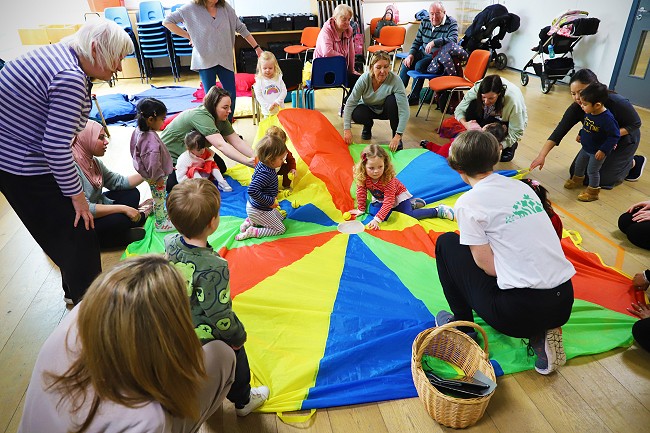
4. Cultivating community cohesion among both children and their parents/carers, particularly through the regular dance and story-telling sessions delivered as part of the R&D
Participant feedback and artist observation demonstrated the social benefits of the project, the opportunity children had to make friends with other children, and the opportunity parents had to come together with other families.
“I love that he gets to dance and play with other kids”
“Loved it, great for daughter's development & social skills” (audience and participant feedback)
We observed a positive impact on the parents attending as well as the children, with parents/guardians citing the physical and emotional health and wellbeing benefits of the sessions such as the impact on their own physical and mental state and how much they enjoyed participating in something like this together with their child/ren.
It has energised me for the day. Lovely to engage with my daughter through listening to a sweet story and creative movement.Parent feedback,
5. More libraries interested in programming the work
All of the library services involved in the delivery of our SEED pilot project have indicated their interest in working with us again.
“I look forward to hearing more once the pilot tour finishes and you start work on the main tour. We’ll definitely want to bring Seed back [including to] a few more libraries across our network.” (library partner feedback)
Additionally, audience members for our SEED pilot who were linked to schools and nurseries close to our partner libraries have also stated their interest in collaborating with us to create a developed engagement offer for SEED linked to the EYFS curriculum area of ‘Understanding the World’.
“We would be really interested in being part of your future work, the performance in June was great and I think it would be great to see how it would work in schools.” (school partner feedback)
6. Developing confidence, creativity and communication skills of Early Years children
Across the project, we witnessed positive developmental changes for the participating children in addition to positive impact on their mood and energy level. This was tracked before and after the children participated in our R&D sessions by inviting the children to place a sticker on a chart next to the face that showed how they were feeling on that day (an activity supported by their grown-ups).
The moodometers showed that the children generally cited their mood as 🙂or 😄as a result of SEED, with a gradual shift towards most of the stickers being clustered around these faces for the moodometers completed afterwards, even where they had been placed around the more unhappy options earlier in the session. However, on some days there was a range of stickers placed across all the face options, which may or may not have been more to do with the joy in the act of putting stickers on the sheet than perhaps a true representation of the children's feelings! Throughout the course of the project we became better at guiding adults to support this activity with their children, so the responses became more representative as the weeks went on.
Mood and energy level were also tracked on our surveys and this was helpful in providing another perspective to supplement what the moodometers seemed to indicate. 96% of survey respondents observed an improvement in their child/ren’s mood (including 65% scoring 5 out of 5). As the children became more engaged and excited and began to understand that they could take part in determining what would happen next, their parents/guardians observed that they became more confident to interact and participate with the performers. 87% of survey respondents also observed a positive impact on their child/ren’s energy level (with 56% scoring 5 out of 5).
6.1 Confidence
57% of survey respondents stated they saw their child definitely increase in confidence (scoring 5 on a scale of 1-5), with a further 37% saying their child was improving in their confidence as a result of SEED (scoring 4 on a scale of 1-5).
“Thank you - my child was very engaged, loved the event & their confidence soared!”
“Initially he was nervous at first as he can be shy at times. Once he got into it he really enjoyed it, joined in and was laughing away! Thank you for a lovely performance!”
“Was good to see her getting involved as she usually is shy. Nice performers encouraged involvement.”
6.2 Creativity
60% of survey respondents stated they definitely saw their child increase in their creativity, with a further 35% said their child was improving in their creativity as a result of SEED. Audience members from across a spectrum of ages were able to bring their own creativity into the space e.g. placing leaves all along the shoots of the seed; shaking bees to create sound; dancing with Kid and Pinto under the blue parachute (the pond). The dancers' friendly approach and style of delivery was very engaging and invited the children into the performance with skill and sensitivity to each group's needs. The interactive nature of the work was particularly effective at capturing and sustaining attention even for the youngest of audience members.
Parent feedback included:
“Happy with dancing and singing, excited about the story”
“The interactiveness of the performance was something new and grabbed the children's attention really well, such as the bees and being in the pond under the blue sheet”
“We loved it, even my 4 month old was mesmerised!”
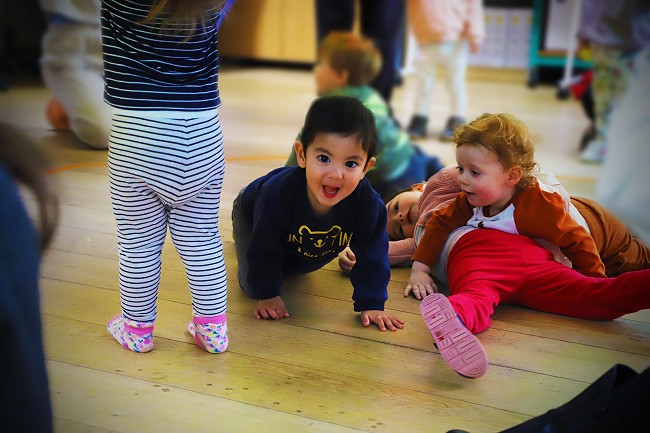
6.3 Communication skills
The artists involved observed a positive impact on children’s communication during the research process, as the participants (both adults and children) became more familiar with what to expect and with the dancer leading the sessions.
For example, workshop facilitator Katie noted in her reflective diary that by week 5, one child “who is usually very quiet in the sessions (although I know from his mum that he does love it and asks to come back) was so chatty and absolutely delighted to be with us today!”
And for another:
“Robert [name changed] was an absolute revelation to me today! He was like a completely different child. I’ve only seen him taking part at the fringes of the group over the past weeks and today he joined in with abandon and seemed delighted by everything we did. It just took him 5 weeks to build the confidence to do that maybe. His mum told me that every week, after the sessions, he naps much better than he usually would. It shows maybe that even though he’s been at the edge, he has been fully engaged, even though he’s only really felt ready to step forward this week.”
She also noted that where the parents felt able to relax and step back a bit as they developed trust in the session leader, the context and felt their children’s needs were being catered for, this had a positive impact on the children’s capacity to communicate fully.
“[The child’s] mum noted that his engagement actually increased once she stood back a bit. She felt that she had perhaps been overly cautious before because she really didn’t want his behaviour to be disruptive for others, but once she stepped back a bit and trusted that he was okay, he was much more engaged - I think this week 5 session was the first time he has ever talked to me!”
Although comments in Katie’s reflective diary suggest that regular attendance had a notably positive impact on the children’s confidence and communication, she also noted that with a friendly approach and style of delivery, which was also carried over into the SEED performance, it was possible to integrate even the first-time attendees:
“there were also some children who were completely new to the session today who were integrating well.”
It was certainly the case that even in the space of a single performance, the performance inspired children to continue talking about SEED, with key contributing factors including the fact that the piece was enjoyable and fun, and that it captured the children’s attention, often cited as sustaining attention far longer than the parents had expected.
Parent feedback included:
“Did not stop talking about the show, the story was really well explained”
“She was chatting to her dad when we got home all about the dancers”
“He was engaged almost the entire time. The longest I have seen him focus on one thing. Very imaginative with the bees and listening to the music to see what he could hear”
Such a lovely experience. My children really enjoyed this event.Parent feedback,
7. Nurtures engagement with reading, books and story-telling
33% of survey respondents cited the opportunity to read new stories in a group or to nurture their child’s love of books (or similar), as being a key factor in them deciding to attend. We know from meeting families during the R&D workshops that this was particularly the case for parents bringing children for whom English was a second language.
The pilot provided an opportunity to explore the best ways to integrate story-telling throughout the piece e.g.
“the text or story-telling involved benefited from being very simple and clear”
“rhyming and/or repetition of a ‘chorus’ for example really helped to give the children power and brought them along with the piece”
“Having a story at the beginning and the end and coming back to the idea of the seasons throughout worked well. The children seemed to find it soothing, especially like a kind of ‘cool down’ at the end. And the story connected everything we had been doing back to nature.” (artist reflection)
8. Young participants gain knowledge in environmental themes of growth and change
SEED provided a context within which the company could initiate conversations about the environment even with very young participants. The seed-planting activity at the end provided an opportunity to start to put some of the ideas in the piece into action, and gave every child attending the gift of a seed they could grow at home, with support from their family.
“...the song that repeated helped them learn about the growth of a plant”
“He's still excited. Even the youngest loved the bees and parachute. Planting seeds at the end was a perfect finish” (audience feedback)
Parents felt that there was an improved awareness of and attitude to nature as a result, and some of the school groups who attended expressed their intention to use SEED as a catalyst for further study.
“It was a lovely way to get children engaged with the world around them.”
“At school, we are going to use the project to link to a piece of class work connected to the seed growing and the seasons - the children were inspired!”
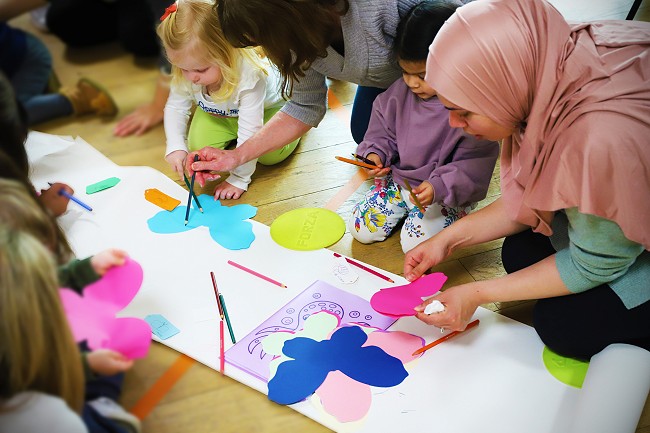
9. Unexpected outcomes
9.1 Building trust and audience loyalty
We had only worked with one of our library performance partners (Guildford Library) before, meaning the project enabled us to extend our network of library partners across services with which we had a pre-existing relationship but also those which were new to us. However, we observed that although this project only represented the second time we had worked with Surrey and Hillingdon libraries, we had already begun to establish a relationship with audiences, with 26% of audience members who responded to our post-performance survey having seen one of our performances before. This indicated strong potential to build a loyal following for these kinds of projects in library venues and the importance of trust-building and word of mouth. It also showed that people were prepared to move between the libraries in their local service to attend things if they were sufficiently interested in doing so.
9.2 Sustainable practice
We had planned to work sustainably throughout the project, as we are actively embedding environmental responsibility into our company’s ethos (as outlined in our Working Sustainability Policy). However, our fantastic designers for the SEED project, Hannah Green and Edel Izquierdo, really showed us what was possible in terms of a more sustainable approach to design e.g. when approaching the design brief for SEED:
- 100% of sewing was either done by hand or with a hand cranking sewing machine, saving on energy.
- 100% of fabric bought was sourced second hand (the only thing this didn’t include was the parachute).
- Overall, approximately 70% of materials used in the design were either sourced second hand or made from sustainable materials.
9.3 Deepening participants’ experience through closer, more creative collaboration with the libraries
We were surprised by the extent to which our engagement with library users on a regular basis, as part of weekly story-telling sessions, brought something new to them that they felt added to their usual experience through Rhyme/Story time sessions.
Participants valued the individualised approach of the workshops and opportunities for one-on-one interaction with audience members during the performances. This was also valuable from the facilitator’s perspective, and R&D facilitator Katie noted the benefits of building a relationship with the children over time (the names here are changed):
“With the benefit of getting to know the children e.g. knowing that George likes the scarves, knowing who will try to run on top of the parachute, knowing that Evie always wants a pink prop and Anaya always wants a red one, it’s possible to really tailor the content to the children and be more sensitive to their needs.” (artist reflection)
The facilitator was attentive to the needs of each child, which supported some quieter children to develop a relationship with them and then to come ‘out of their shell’ towards the end. This was particularly impactful where families were attending the R&D sessions regularly and therefore benefited from this becoming part of the young children’s structure and routines.
“A lot of parents wanted to talk about the opportunity continuing - they wanted to know if it was possible that the sessions could continue, as they were keen to sustain the momentum and the sense of routine for their children.”
“The parents tell me that so many of the children are asking to come back, week on week - it has become part of their routine and they look forward to it.” (artist reflection)
9.4 Recommended reading list
Some libraries went above and beyond to connect with the world of the work and expand upon its themes. We created a recommended reading list based on our research (available here), and some of our library partners created beautiful book selections and wall displays that were inspired by that list.
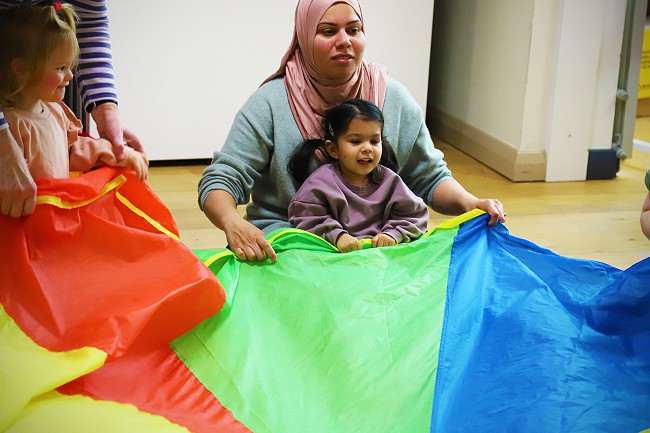
SEED full credits
Director: Katie Green
Choreographed and performed by Megan Griffiths and Deepraj Singh
Understudy Aimee Dulake
Design by Hannah Green and Edel Izquierdo
Writing by Anna Selby
Music by Dougie Evans
Costume design by Chloe Mead
Made By Katie Green Producer: Vicky Thornton (Clearcut)
Project Manager: Charlotte Mackie
Project Mentor: Hannah Lefeuvre
Access Consultation: Lily Norton
Sustainability Consultation: Danielle Pipe
Filming and photography by Dan Martin and Floyd C Konde
The SEED project was supported in 2024 by the National Lottery through Arts Council England, co-commissioned by Surrey Libraries and Active Surrey. Our pilot performances in June 2024 were supported by Surrey Libraries, Medway Libraries/Applause Touring and Northamptonshire Libraries/Library Plus. Our research for the project was also supported by The Hive in Guildford and Ruislip Manor Library (Hillingdon Libraries).